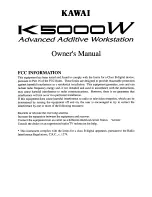
English
Installation and operating instructions Wilo-VBH
21
case of fire extinguishing systems which are used
only rarely, in order to ensure that an automatic
flushing device (32) can be connected for the pur-
pose of replacing any stagnating water in the inlet
pipe with a fresh supply. Once the connection to
the supply network has been set up and the tank
has been filled through the float valve, the closing
level needs to be set by adjusting the rods and
shifting the position of the float. The valve should
close no later than when the level reaches a point
approximately 100 to 50 mm below the lower
edge of the overflow.
7.4.2 Diaphragm valve
In the case of break tanks which are fed by means
of diaphragm valves, a connection flange (2)
(standard flange as per DIN PN10) is located on the
cover and a lead-through (1) for one pilot float
valve (24) on the longitudinal side. In addition to
the description contained here, the installation
instructions packaged with the valves are also to
be observed during assembly and installation. The
installation of the pilot valve float valve (24) is
accomplished in the same way as the installation
of a float valve as described under 7.4.1. The dia-
phragm valve (21) must be installed in horizontal
position at a sufficient height above the tank (see
Fig. 4). A check valve (23) with the same nominal
diameter should be provided both upstream and
downstream from the diaphragm valve. The pipe
from the valve to the tank is to be guided to the
connection flange provided for this purpose and
connected with screws to the threaded bushings
provided. It should be taken into consideration in
this connection that the weight of the diaphragm
valve, of all additional fittings and the weight of
the pipe are not permitted to impact on the tank,
but rather must be transferred to the solidium
(wall or ceiling of the room) by means of pipe
clamps (20) or other suitable measures.
WARNING
! Danger of injury and danger of
damage to the tank.
The cover of the break tank cannot be walked
on! Non-permitted loads on the cover can lead
to destruction.
A control line (22) is to be laid from the diaphragm
valve to the float valve after installation of the
diaphragm valve and the supply line has been
completed. This will be mounted on the dia-
phragm valve (21) at the screwed connection pro-
vided for this purpose on the valve head and
guided and fastened to the pilot float valve as
allowed by local circumstances.
7.5 Electrical connection
DANGER! Danger of death!
Improper electrical connections can lead to fatal
electrical shocks.
• Always have the electrical connection per-
formed by a qualified electrician.
The float switch (low-water signal transmitter)
(11) is the only electrical connection to be made
with the control device of the pressure boosting
system. The description of the control device and
its wiring diagram are to be observed without fail
to this end. The float switch is available as a
changeover contact, i.e. it can be connected both
as a normally open contact and as a normally
closed contact. (Fig. 7) Consult the associated
installation and operating instructions to deter-
mine which switching logic must be utilised for
the control device in question.
DANGER! Danger of death!
• The max. switching voltage, rating and switch-
ing current of the float switch may not be
exceeded.
The control voltage of the pressure boosting sys-
tem control device can also be found by consult-
ing the associated installation and operating
instructions. If this control voltage is greater than
the maximum switching voltage of the float
switch (see Section 5.2 Technical data), then this
float switch may not be connected. Wilo after-
sales service should be contacted in such cases in
order to replace the float switch with a different
model.
8 Commissioning
The tank must be cleaned and sufficiently flushed
before it is commissioned. Contaminants should
not be permitted to find their way into the pres-
sure boosting system and into the potable water
network while these tasks are being performed.
See in this connection Section 7.2 Hygiene.
9 Maintenance and cleaning
Wilo break tanks require no maintenance for func-
tioning. It is recommended that the tank be
checked for leaks and the inlet and drain lines for
proper functioning when maintenance work is
performed on the pressure boosting system.
It is urgently recommended that the tank be
cleaned at regular intervals. Cleaning and disin-
fection is particularly necessary in connection
with usage in potable water applications. Applica-
ble laws, regulations and standards are to be taken
into account to this end. Please observe the
instructions to be found under Point 7.2 Hygiene
to this end. The tank must be drained completely
before work can be performed on it. Work inside
the tank should not be carried out unless another
person is present outside the tank.
Maintenance and repair may only be carried out
by qualified experts!
Содержание VBH Series
Страница 2: ...Fig 1a VBH 150 600 L round GII VBH 800 1000 L round GII...
Страница 3: ...Fig 1b VBH 150 500 L rectangular GIII...
Страница 4: ...Fig 1c VBH 150 500 L rectangular GIII...
Страница 5: ...Fig 1d VBH 1500 3000 L rectangular GIII...
Страница 6: ...Fig 1e VBH 600 L round FLA VBH 800 1000 L round FLA...
Страница 7: ...Fig 1f VBH 600 L rectangular FLA...
Страница 8: ...Fig 1g VBH 800 1000 L rectangular FLA...
Страница 9: ...Fig 1h VBH 1500 3000 L rectangular FLA...
Страница 10: ...Fig 2 Fig 3...
Страница 11: ...Fig 4...
Страница 12: ...Fig 5a Fig 5b...
Страница 13: ...Fig 6a Fig 6b...
Страница 14: ...Fig 7...
Страница 53: ......
Страница 54: ......
















































